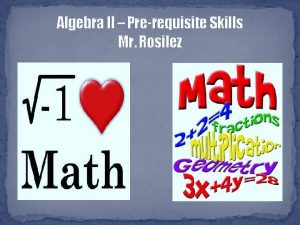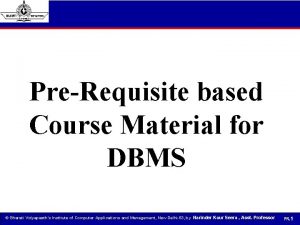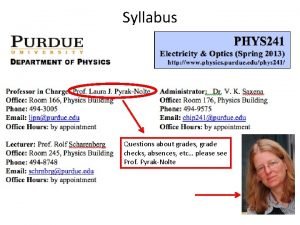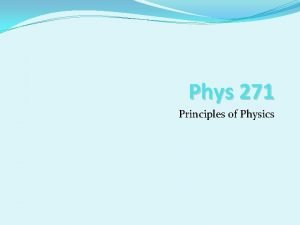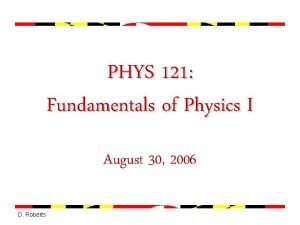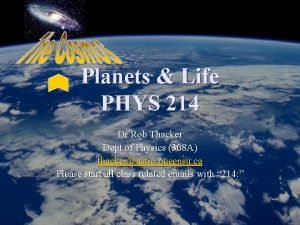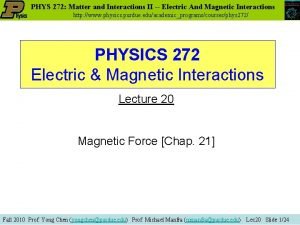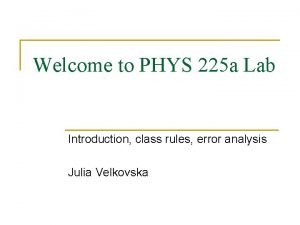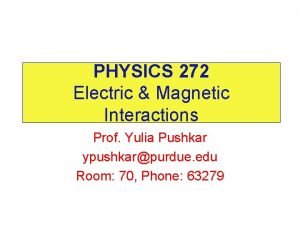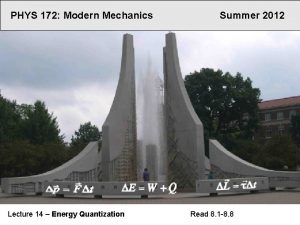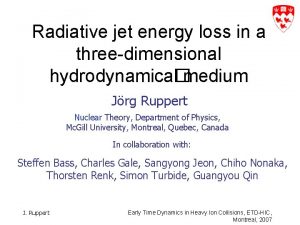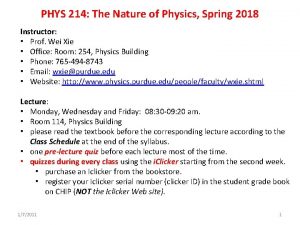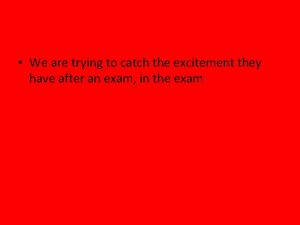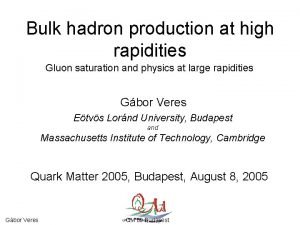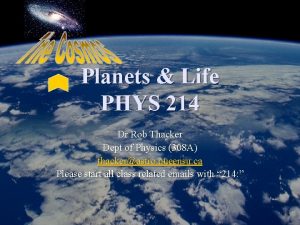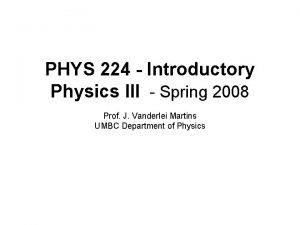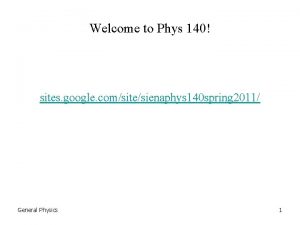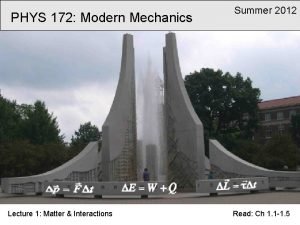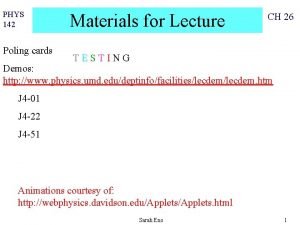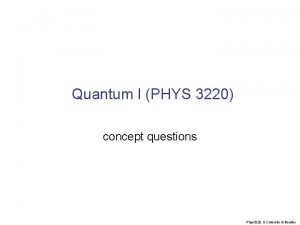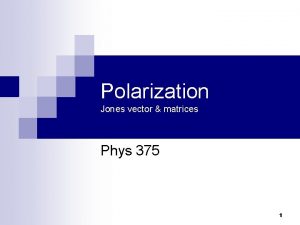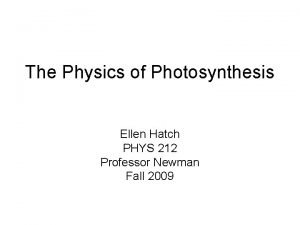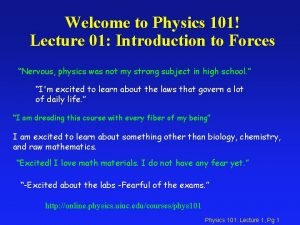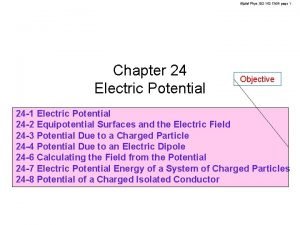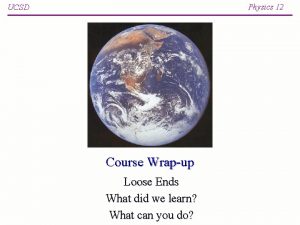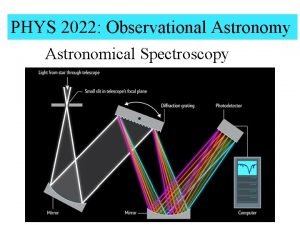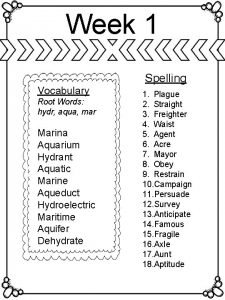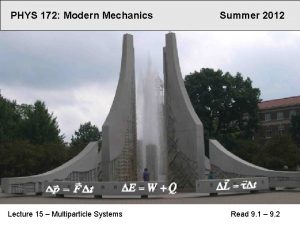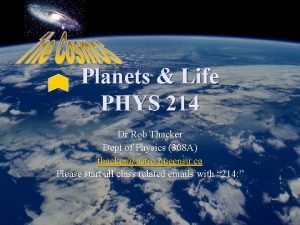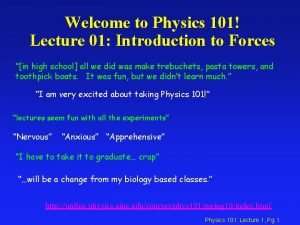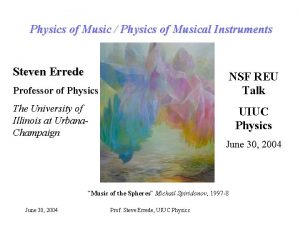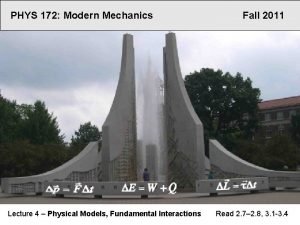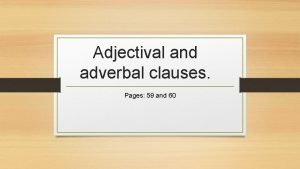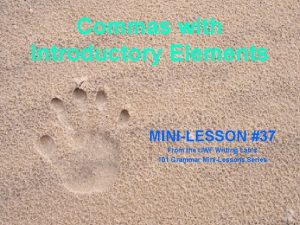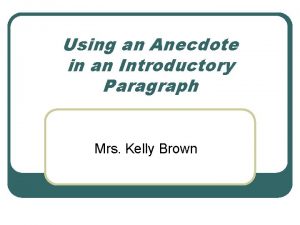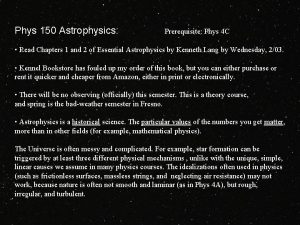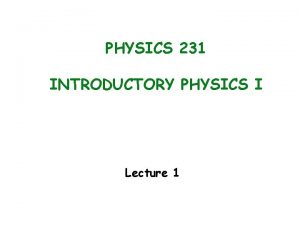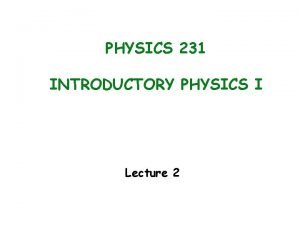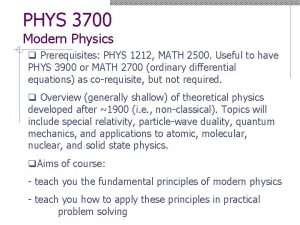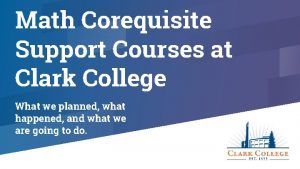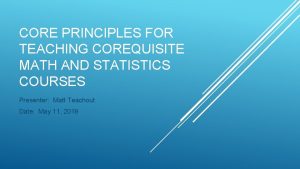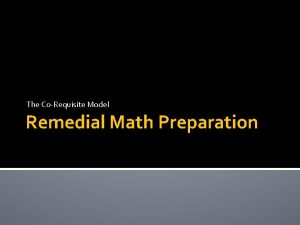PHYS 201 Introductory Physics I Corequisite Prerequisite PHYS






















































![Transformation Equations r = [ x 2 + y 2 ] The r equation Transformation Equations r = [ x 2 + y 2 ] The r equation](https://slidetodoc.com/presentation_image_h2/8b54b2188023ccf564dea2a388cc7caa/image-55.jpg)













- Slides: 68

PHYS 201 Introductory Physics I Corequisite: Prerequisite: PHYS 201 L (lab) MATH 107 & 110, or MATH 117 Precalculus Instructor: title: office: phone: e-mail: homepage: Dr. Johnny B. Holmes Professor of Physics AH 012 321 -3448 jholmes@cbu. edu facstaff. cbu. edu/~jholmes

Biology and Physics: Two Cultures “In general, physicists stress reasoning from a few fundamental principles – usually mathematically formulated – and seek to build understanding from the simplest possible models. They view the world quantitatively and pay much attention to constraints, such as conservation laws, that hold regardless of a system’s internal details. Biologists, on the other hand, focus on real examples and emphasize structure–function relationships; they rarely stress quantitative reasoning. The systems they deal with are almost always highly complex, with many interacting parts that lead to emergent phenomena. Biologists recognize that their discipline is subject to the historical constraint that natural selection can only act on pre-existing molecules, cells, and organisms, so their reasoning often depends more strongly on what exists than on ‘fundamental’ abstract principles or simplified pictures. ” From article by Dawn Meredith and Edward Redish in Physics Today, July 2013 issue, page 39.

Need for Physics in the Life Sciences “… The life sciences have grown explosively as new techniques, new instruments, and a growing understanding of biological mechanisms have enabled biologists to better understand the physiochemical processes of life at all scales, from the molecular to the ecological. Quantitative measurements and modeling are emerging as key biological tools. …” From article by Dawn Meredith and Edward Redish in Physics Today, July 2013 issue, page 38.

Formulas and Equations Physics involves chugging and plugging into equations to get numerical answers, but physics involves more than that. Equations show different things are related, i. e. , how some things change based on how other things change. Equations allow us to not only calculate, but to predict and to explain. Note: Equations in physics won’t use the familiar x and y of math, but instead will use physical quantities like P (for pressure), v (for velocity), T (for temperature), etc.

PHYS 201 Introductory Physics I • • Description of motion in 3 dimensions Causes of motion: forces Causes of rotation: torques Concept and types of energy; concept of power Concept of momentum: collisions (and explosions) Pressure and fluid flow Heat and methods of heat transfer Sound: what is it and what do we hear

PHYS 202 (next semester) Introductory Physics II • Electricity and basic electric circuits (e. g. , voltage, currents, and EKG’s) • Magnetism and generation of electricity & use in instruments (e. g. mass spec, MRI) • Light: what it is, how it works, and how we see (e. g. , lenses, microscopes, and spectroscopes) • Atoms and atomic theory: basis of chemistry • Radioactivity: what it is and how we measure it • Nuclear physics (e. g. , nuclear weapons, nuclear power)

Introduction to PHYS 201 Grading (explained in the syllabus) • 5: 5 tests, each counts as one grade • 1: 1 set of 9 regular collected homework problems which counts as one grade • 2: 21 computer homework programs in two sets, each set counts as one grade • 3: final exam, which counts as 3 grades Total: 11 grades, final grade will be based on the average of these 11 grades.

Absences • If you miss 3 or fewer classes, your lowest single score will be dropped (not counting homework scores). If the final is lowest, it will count only 2 instead of 3 times. Thus, if you have 3 or fewer class absences, the total will be based on the remaining 10 grades.

Regular Homework (RH) • There are 9 regular collected homework problems for the semester. These must be done and written up using the 7 step paradigm described in the syllabus. This paradigm is not good for the problems with obvious solutions, but is good for those problems that do not have obvious solutions. It is also a good way of communicating your thinking.

Regular Homework (RH) 1. 2. 3. 4. I want to and I can (motivation) Draw a diagram and record your knowns Indicate what you are looking for Brainstorm – how are what you are looking for related to what you know? 5. Plan your attack – write down the equations 6. Execute the attack – include all units 7. Is your answer reasonable?

Computer Homework (CH) • The computer homework problems are designed to give you graded practice. They emphasize getting the answer right the first time. If you get an answer wrong, the computer will tell you right away, and often tell you how to get it right. It is your task to actually get them correct. A random number generator will change the numbers so you will have to learn how to do them and not just remember the right answers.

Tests The tests emphasize familiarity, recognition and speed. The material on the tests should be somewhat familiar. You should be able to recognize the type of problem, the basic principles involved, and determine which techniques to apply. Note: Calculators are recommended, but sharing calculators is not allowed and no internet connected devices are allowed during the tests. You should keep your calculator, hands, and eyes on the desk and not in your lap.

Tests – cont. This course emphasizes basic principles and problem solving, not memorization. To reduce the perceived need to memorize, you are permitted to bring to each test one 8. 5” x 11” sheet of paper with information on one side. You may bring two of these sheets to the final. (Writing on one side only). Warning: These sheets are meant to be a help, not a complete crutch. As you make up your sheets, ask yourself if you will be able to answer questions like the ones you are preparing for on a national (e. g. MCAT, OAT, DAT, GRE) test without these sheets. If you do plan on taking such nationally normed tests, you should be able to use your sheets as a review to study from.

Math Review Three of the first six computer homework programs deal with a review of math: Linear Equations, Simultaneous Equations, and Quadratic Equations. You should be able to do these right now. The sooner you do these programs, the better. The due dates for these programs have been spaced out over the first week only to even out the homework load.

Math Review #1: Linear Equations Review: One Equation: ax + dy = c (we know a, d, and c; we don’t know x and y). This is one equation in two unknowns. There are lots of correct answers to this. Example: 5 x + 3 y = 35. Several possible answers are: (x=4, y=5), (x=7, y=0), (x=-5, y=20).

Review: One Equation: ax + dy = c can be written in the normal form y = mx + b where m = -a/d and b = +c/d. Thus the equation 5 x + 3 y = 35 becomes y = (-5/3)x + (35/3) y Every point on this line satisfies the equation 10 -5 (x=4, y=5), (x=7, y=0), (x=-5, y=20). 5 -10 x

Math Review #2: Simultaneous Equations • However, if we have two equations with two unknowns, then there is usually just one possible answer: Example: 5 x + 3 y = 35 AND 2 x - y = 3. • In this case, we can solve for one unknown (say y) in terms of x. Using the second equation: y = 2 x - 3.

Math Review #2: Simultaneous Equations 5 x + 3 y = 35 AND 2 x - y = 3. • Using this relation for y: y = 2 x - 3 in the other (first) equation yields: 5 x + 3(2 x - 3) = 35 , or 5 x + 6 x - 9 = 35, or 11 x = 44, or x = 44/11 = 4 = x. Now we can use this value for x in the y = 2 x - 3 to get y = 2(4) - 3 = 5 = y.

Math Review #2: Simultaneous Equations 5 x + 3 y = 35 AND 2 x - y = 3. • Check of our answer: (x=4, y=5) 5 x + 3 y = 35, or 5(4) + 3(5) = 35, or 20+15 = 35 which checks out; and 2 x - y = 3, or 2(4) -5 = 3, or 8 - 5 = 3 which also checks out. Hence we have our solution.

Math Review #2: Simultaneous Equations 5 x + 3 y = 35 AND 2 x - y = 3. Graphically, each equation graphs as a straight line, and the y single solution (in our case, x=4, y=5) is the intersection of the two lines x 10 -5 5 -10

Math Review #2: Simultaneous Equations The computer homework program on Simultaneous Equations has up to three equations with three unknowns. You can proceed the same way. 1. Use one equation to eliminate one of the three unknowns in the other two equations. 2. Then use one of these two equations to eliminate a second unknown from the last equation. 3. Then use the last equation to solve for the remaining one unknown.

Math Review #3 a: Angles Because space is three dimensional (we’ll talk about this soon), we need angles. What is an angle? How do you measure an angle?

Math Review #3 a: Angles How do you measure an angle? 1) in circles (cycles, rotations, revolutions) 2) in degrees - but what is a degree? Why do they break the circle into 360 equal degrees? 3) in radians - but why use a weird number like 2 p for a circle? Why does p have the weird value of 3. 1415926535… ?

Math Review #3 a: Angles Full circle = 360 o (Comes from year - full cycle of seasons is broken into 365 days; but 365 is awkward number; use “nicer” number of 360. ) Full circle = 2 p radians (Comes from definition of angle measured in radians: = arclength / radius =s/r) s r

Math Review #3 b: Trig Besides angles, we will need the functions associated with angles. The trig functions are based on a right triangle:

Math Review #3 b: Trig • sin( ) = opposite/hypotenuse = y/r • cos( ) = adjacent/hypotenuse = x/r • tan( ) = opposite/adjacent = y/x • (The hypotenuse is the side opposite the right angle. ) r y x

What is Physics? First of all, Physics is a Science. So our first question should be: What is a Science?

Science • What is a science? • Physics is a science. Biology is a science. • Is Psychology a science? • Is Political Science a science? • Is English a science? What makes a field of inquiry into a science?

Scientific Method What makes a field of inquiry into a science? • Any field that employs the scientific method can be called a science. So what is the Scientific Method? • What are the “steps” to this “method”?

Scientific Method 1. Define the “problem”: what are you studying? 2. Gather information (data). Ideally, your experiments should be repeatable. 3. Hypothesize (try to make “sense” of the data by trying to guess why it works or what law it seems to obey). This hypothesis should suggest how other things should work. So this leads to the need to: 4. TEST, but this is really gathering more information (really, back to step 2).

Scientific Method Is the scientific method really a never ending loop, or do we ever reach “THE TRUTH” ? Consider: can we “observe” or “measure” perfectly? If not, then since observations are not perfect, can we perfectly test our theories? If not, can we ever be “CERTAIN” that we’ve reached the whole “TRUTH” ?

Scientific Method If we can’t get to “THE TRUTH”, then why do it at all? We can make better and better observations, so we should be able to know that we are getting closer and closer to “THE TRUTH”. Is it possible to get “close enough”? Look at our applications (engineering): is our current understanding “good enough” to make air conditioners?

Physics Now Physics is a science, but so are Chemistry and Biology. How does Physics differ from these others? It differs in the first step of the method: what it studies. Physics tries to find out how things work at the most basic level. This entails looking at: space, time, motion (how location in space changes with time), forces (causes of motion), and the concept of energy.

Metric System Since physics is a science, and science deals with observations, physics deals with MEASUREMENTS. How do we MEASURE? What do we use as the standard for our measurements? In this course we will look at common units of measurement as well as the METRIC units of measurement.

Metric System: Basic quantities • Some measurements are basic, and some are combinations of other more basic ones: • What are the basics: (MKS system) – length (in Meters) – amount of “stuff” called mass (in Kilograms) – time (in Seconds) • What are some of the combinations: – speed (distance per time) – area (distance times another distance) – lots of other things

Prefixes The metric unit for length is the meter. We can indicate a multiple of meters or a fraction of meters by using prefixes: • centi (cm) =. 01 meters = 10 -2 m • milli (mm) =. 001 meters = 10 -3 m • micro ( m) =. 000001 meters = 10 -6 m • nano (nm) =. 00001 meters = 10 -9 m • pico (pm) =. 0000001 meters = 10 -12 m

Prefixes – cont. (The prefixes on this page will not be used in this course, but you may run into them in future courses. ) • • femto: atto: zepto yocto (fg) = 10 -15 grams (ag) = 10 -18 grams (zg) = 10 -21 grams (yg) = 10 -24 grams

Prefixes For bigger values we have: • kilo (km) = 1, 000 meters = 103 m • mega (Mm) = 1, 000 meters = 106 m • giga (Gm) = 1, 000, 000 meters = 109 m • tera (Tm) = 1, 000, 000 meters = 1012 m These prefixes can be applied to many different units, not just meters. These will be used throughout the course.

Time How do we measure time? year month week day hour minute second

Time Year: time to make one cycle through seasons Month: time for moon to make one cycle through its phases Week: 7 days (one for each “planetary” body visible to naked eye: SATURNday, SUNday, MOONday, etc. ) Day: time for sun to make one cycle across the sky Hour: Break day into day and night; break each of these into 12 parts - like year is broken into 12 months. Minute: a minute piece of an hour (1/60 th) Second: a minute piece of a minute - or second minute piece of an hour.

Length What units do we use to measure length?

Length Foot (whose foot? ) Inch (length of a section of your finger) Mile (1, 000 double paces of a Roman legion) Nautical mile (1 arc second around the earth = 1. 15 miles) League (3 miles), fathom (6 feet) , chain (100 links either 20 yards or 100 feet, or 10 yards in football) , etc. Meter The meter was originally defined as one ten-millionth (0. 0000001 or 10 -7) of the distance, as measured over the earth's surface in a great circle passing through Paris, France, from the geographic north pole to the equator. One meter is now defined as the distance traveled by a ray of electromagnetic (EM) energy through a vacuum in 1/299, 792, 458 (3. 33564095 x 10 -9) of a second. (We’ll worry about MASS later. )

Position Before we can analyze motion, which is how something’s position changes with time, we need to analyze position. How do we locate something (that is, indicate its position)?

One Dimension In one dimension, we can specify the position with one number: the distance from some specified starting place. Example: A mark on a rope can be specified by how far that mark is from one end of the rope.

Two Dimensions In two dimensions, we have more options in specifying the location of an object. Example: where is Memphis? • We could use a rectangular system (x, y) that specifies how far North (y) and how far East (x) it is from some specified location. • We could also use a polar system (r, ) that specifies how far it is (r, straight line distance) along with the direction ( , angle from due North).

Two and Three Dimensions Notice that both systems need TWO numbers hence the TWO DIMENSIONS. With THREE dimensions, we need three numbers and we have even more options. Example: Locate an airplane in the sky. Some of the options are: rectangular (x, y, z), spherical (r, , ), cylindrical (r, , z).

Number of spatial dimensions • It is easy to see the need for three dimensions. Do we need FOUR? • What would a fourth dimension be like? • Experimentally, what do we find for the space that we live in - how many spatial dimensions do we have? • Most of the time in this course we will work in two dimensions - many cases can be reduced to this and it is mathematically easier. • Open versus Closed Universe?

Vectors How do we work with a quantity that needs two (or more) numbers to specify it (like position does)? We can work either with a group of numbers sometimes put in parenthesis, or we can work with unit vectors that we add together: (x, y) or x*x + y*y (where x indicates the x direction, and x indicates how far in that direction).

Vectors • The individual numbers in the vector are called components of the vector. • There are two common ways of expressing a vector in two dimensions: rectangular and polar.

Vectors Rectangular (x, y) is often used on city maps. Streets generally run East-West or North. South. The distance East or West along a street gives one distance, and the distance along the North-South street gives the second distance - all measured from some generally accepted origin. Example: In Memphis, the origin is Madison & Front. Madison is the dividing street between North and South, and Front is the dividing street between East and West.

Vectors If you are at home (the origin), and travel four blocks East and then three blocks North, you will end up at position A. Position A relative to your house is then (4 blocks, 3 blocks) where the first number indicates East (+) or West (-), and the second number indicates North (+) or South (-).

Vectors If you had a helicopter or could walk directly there, it would be shorter to actually head A straight there. How do you specify 3 bl the location of point A this way? 4 bl

Vectors • The distance can be calculated by the Pythagorian Theorem: A r = [ x 2 + y 2 ] = 5 bl. • The angle can be 5 bl 3 bl calculated using the inverse tangent function: 4 bl = tan-1 (y/x) = 37 o

Transformation Equations These two equations are called the rectangular to polar transformation equations: r = [ x 2 + y 2 ] = tan-1 (y/x). Do these equations work for all values of x and y, including negative values?
![Transformation Equations r x 2 y 2 The r equation Transformation Equations r = [ x 2 + y 2 ] The r equation](https://slidetodoc.com/presentation_image_h2/8b54b2188023ccf564dea2a388cc7caa/image-55.jpg)
Transformation Equations r = [ x 2 + y 2 ] The r equation does work all the time since when you square a positive or negative value, you still end up with a positive value. Thus r will always be positive (or zero), never negative.

Transformation Equations = tan-1 (y/x). However, theta equation depends on the signs of x and y. From this equation you get the same angle if x and y are both the same sign (both positive or both negative), or if one is positive and one negative - regardless of which one is the positive one. How do we work with this?

Transformation Equations = tan-1 (y/x) Some scientific calculators have a built-in transformation button. However, you should know how to do this the “hard way” regardless of whether your calculator does not have that button.

Transformation Equations = tan-1 (y/x) Note: If x is positive, you must be in the first or fourth quadrant (theta between -90 o and +90 o). Your calculator will always give you the right answer for theta if x>0. If x is negative, you must be in the second or third quadrant (theta between 900 and 270 o). All you have to do if x<0 is add 180 o to what your calculator gives you.

Inverse Transformations Can we go the other way? That is, if we know (r, ) can we get (x, y) ? If we recall our trig functions, we can relate x to r and : x = r cos( ), and similarly r y = r sin( ). x Do these work for all values of r and ? YES! y

Inverse Transformations x = r cos( ), and y = r sin( ) Example: If (r, ) = (5 bl, 37 o), what do we get for (x, y) ? x = r cos( ) = 5 bl * cos(37 o) = 4 bl. y = r sin( ) = 5 bl * sin(37 o) = 3 bl. [Note that this is the (x, y) we started with to get the (r, ) = (5 bl, 37 o). ]

Motion involves changing the position of an object during a time interval. If position is a vector, then the change in position should also be a vector. The change in position involves the difference between the final and initial positions. But before we concern ourselves with subtraction (finding a difference), we need to look at addition!

Addition of Vectors Suppose you start from home (the origin), and go 4 blocks East (x 1=4 bl) and 3 blocks North (y 1=3 bl) to point A. Then you leave point A and go 2 blocks West (x 2= -2 bl) and 4 blocks South (y 2= -4 bl). Where do you end up (relative to the origin where you started)?

Addition of Vectors ( 4 bl, 3 bl) + ( -2 bl, -4 bl) -------= ( 2 bl, -1 bl) ? ? ? (2 blocks East, 1 block South) YES! When we add vectors expressed in rectangular form, we just add the individual components!

Addition of Vectors Does it work the same way in polar form? ( 4 bl, 3 bl) --> (5 bl, 37 o) + ( -2 bl, -4 bl) --> (4. 5 bl, 243. 5 o) ---------------= ( 2 bl, -1 bl) --> (2. 2 bl, -26. 5 o) Note that 5 bl + 4. 5 bl does NOT equal 2. 2 bl, and 37 o + 243. 5 o does NOT equal -26. 5 o ! Adding the polar components does NOT WORK!

Addition of Vectors When we add vectors, we can only add them when they are in RECTANGULAR form. If they are in polar form, we must first transform them into rectangular form, then add them in rectangular form (by adding the components), then convert them back into polar form! You will get practice with this in the Vector Addition Computer Homework Program.

Subtraction of Vectors If x + y = c , this can be re-written as x = c - y. Can we do the same with vectors, that is, if (x 1, y 1) + (x 2, y 2) = (x 3, y 3) then does (x 1, y 1) = (x 3, y 3) - (x 2, y 2) ? YES as long as the vectors are in rectangular form!

Addition of Vectors Do the previous rules for addition of location vectors also work for other vector quantities? YES Consider the idea of FORCE. Is FORCE a vector? We can answer this by asking: does force have a magnitude and a direction (can you have a force acting sideways) ?

Vectors versus Scalars The answer is YES, so FORCE is a vector, and several forces acting on the same object can be added together as vectors to get the resultant force. We will play with this idea in the first lab experiment. Is TIME a vector? (Can you move sideways in time? ) No - time is not a vector; it is a SCALAR.
 Prerequisite skills for algebra 1
Prerequisite skills for algebra 1 Group discussion meaning
Group discussion meaning Performance renewal and recontracting
Performance renewal and recontracting Dbms prerequisite
Dbms prerequisite Prerequisite program template
Prerequisite program template It is an active process of discovery
It is an active process of discovery Examples of prerequisite programs for haccp
Examples of prerequisite programs for haccp Uci ics catalogue
Uci ics catalogue Uci cs catalogue
Uci cs catalogue Prerequisite of equality?
Prerequisite of equality? 7 principles of haccp
7 principles of haccp Uc irvine orientation
Uc irvine orientation University physics with modern physics fifteenth edition
University physics with modern physics fifteenth edition Ib physics ia examples
Ib physics ia examples Why does it happen
Why does it happen Purdue phys 241
Purdue phys 241 Phys 271
Phys 271 Phys 121 umd
Phys 121 umd Http //www.phys.hawaii.edu/ teb/optics/java/slitdiffr/
Http //www.phys.hawaii.edu/ teb/optics/java/slitdiffr/ Tsms phys ed
Tsms phys ed Phys 214
Phys 214 Phys 272
Phys 272 Phys 225
Phys 225 Coulombs in si units
Coulombs in si units How to calculate experimental uncertainty
How to calculate experimental uncertainty Phys 172
Phys 172 Chiho nonaka
Chiho nonaka Phys 214
Phys 214 Phys 250 ubc
Phys 250 ubc Http //vsg.quasihome.com
Http //vsg.quasihome.com Uiuc phys 102
Uiuc phys 102 Phys. rev. c
Phys. rev. c Phys 214
Phys 214 Phys 224
Phys 224 Phys140
Phys140 Att phys medical abbreviation
Att phys medical abbreviation Purdue physics 172 past exams
Purdue physics 172 past exams Phys 142
Phys 142 Quantumi
Quantumi Jones matrix for half wave plate
Jones matrix for half wave plate Phys 212 equation sheet
Phys 212 equation sheet Physics 101 uiuc
Physics 101 uiuc Aljalal phys 102
Aljalal phys 102 Phys courses ucsd
Phys courses ucsd Phys2022
Phys2022 Phys 244
Phys 244 25 spelling
25 spelling Particl clicker
Particl clicker Phys 241 purdue
Phys 241 purdue Phys. rev. c
Phys. rev. c Phys 214
Phys 214 Physics 101 uiuc
Physics 101 uiuc Phys 398 uiuc
Phys 398 uiuc Aljalal phys 102
Aljalal phys 102 Ucsd physics
Ucsd physics Iterative prediction of motion
Iterative prediction of motion Meeting agenda introduction
Meeting agenda introduction Introduction paragraph strategies
Introduction paragraph strategies List of introductory phrases
List of introductory phrases Introductory chemistry 5th edition nivaldo j. tro
Introductory chemistry 5th edition nivaldo j. tro Adjectival subordinate clause
Adjectival subordinate clause Middle school introduction paragraph examples
Middle school introduction paragraph examples Reported speech advise
Reported speech advise Keeping your hands clean and dry essay
Keeping your hands clean and dry essay Introductory elements examples
Introductory elements examples Comma introductory clause
Comma introductory clause Army traffic safety introductory course
Army traffic safety introductory course What is a introductory element
What is a introductory element Anecdote
Anecdote
